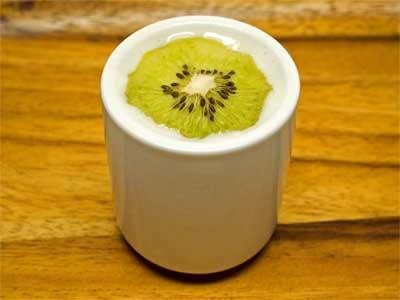December 5, 2011
Amuse-Bouche

lait de fenouil et gingembre
(fennel-ginger soup)
“Is it soup, yet?” is a famous line from a now almost forgotten soup commercial of the 1970s where a child comes into the kitchen, obviously coming from a chilly outside, and asks the afore stated question. The commercial implied that Lipton’s dehydrated soups were better than Campbell’s condensed soups because they took a bit longer to prepare. For me, the commercial always represented the additional concept of eating warm soup on a cold day to help warm you up. Since I live in a moderate climate and even on what we call a cold day, there’s no one at the door welcoming me with warm soup. The concept will have to live with all the other fantasies I learned from television like there is a perfect family Christmas celebration and love lasts forever.
Amuse-bouches are a bit like the warm soup in the commercial. In a restaurant, they are often served soon after the guest is either seated or after they have ordered their meal. It’s not immediately after walking through the door, but it can be soon thereafter. It is a way to welcome the guest into the establishment.
In my home, dinner guests are invited into the living room upon arrival. There, we share an aperitif along with one or two or three amuse-bouches. Depending on the conversation and my service pacing, it can be up to an hour before everyone moves to the dining room table for the first course (and the real drinking).
Since soup is often the first course, why not also serve it as an amuse-bouche? That can easily be done as long as you modify the soup, if necessary, to fit within the restrictions of an amuse-bouche. First, because an amuse-bouche is only one or two bites, the flavor of the soup needs to be fairly intense. Usually it must be more intense than you would serve as a entire first-course. Second, the soup has to scale to the serving dish, bowl, cup, or glass used. If the soup has big chunks, they may not fit in a small serving dish. Does the soup need a spoon, or can it be drunk from a cup? Lastly, is the spoon homogenized or does it require mixing while eating? This can also dictate how an amuse-bouche is served.
In looking at the fifty plus soup recipes on this website there are many that would work as an amuse-bouche with little or no modification. Lait de fenouil et gingembre is a good example. The only modification would be the quantity of materials required per serving. The original recipe prepared two 200-ml (7-oz) portions, enough to fill eight of the 50-ml (1-2⁄3-oz) capacity cups I use for serving the soup as an amuse-bouche.
The main reason this soup was chosen to start this particular meal was because it contained ginger, and the meal was ginger-themed. But it turned out to be good for a number of reasons besides its ingredient list. The soup was prepared many hours before the guests were scheduled to arrive. I just left it in a small saucepan off the heat on the edge of the stove. When the guests arrived, I moved it to a warm burner to reheat. I had foamed the soup in a high-speed blender at the same time I originally pureed it. Even a number of hours later, the foam still held.
But the soup was not without it issues. The flavor was not as intense as I would like from an amuse-bouche. To overcome this and in order to ease out as much flavor as I could, I added the maximum salt I could without being able to taste any salt. I served a somewhat crisp, light, and slightly-sweet rosé as the aperitif so as to not compete. I didn’t tell my guests what the soup was made from until after they tasted it. This forced them to concentrate more as they are tasting the soup.
Another issue is appearance. The soup is light green to white in color depending on the color of the fennel bulb and how foamy the liquid is after pureeing. (Bubbles lighten the color.) Unfortunately, I didn’t have any appropriate dark-colored serving vessels. Being stuck with white, I had to figure out a way of decorating the soup in an attractive, appealing, and simple manner. The answer came from my storehouse of dried fruit slices. In this case, it came in the form of a thin, dried slice of kiwi fruit. I picked slices that were small enough to fit the opening of the cups. One was placed on each of the cups just before serving the soup. The fruit starts to hydrate almost immediately, so it must be served immediately after the fruit is applied. The slice of kiwi also hides the appearance of the soup from the guests so the mystery as to what they are tasting is increased a bit.
© 2011 Peter Hertzmann. All rights reserved.
